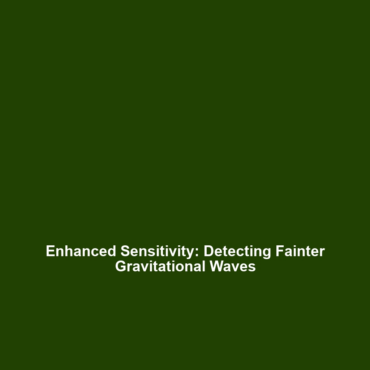How Increased Sensitivity Will Allow Us to Detect Smaller and More Distant Gravitational Wave Events
Introduction
Gravitational waves, ripples in spacetime caused by some of the universe’s most violent phenomena, continue to revolutionize our understanding of the cosmos. Recent advancements in detection sensitivity are making it possible to observe smaller and more distant events than ever before. This increased sensitivity significantly enhances our observational capabilities, allowing scientists to delve deeper into the mysteries of the universe, thereby unlocking new avenues of research in astrophysics and fundamental physics. Understanding how increased sensitivity aids in the detection of these events is crucial for both scientists and enthusiasts alike.
Key Concepts
The Nature of Gravitational Waves
Gravitational waves are caused by accelerating masses, such as merging black holes or neutron stars. These waves travel at the speed of light and carry information about their origins, fundamental forces, and the nature of gravity itself.
Enhanced Detection Techniques
Recent innovations in laser interferometry and cryogenic technology have improved the sensitivity of detectors such as LIGO and Virgo. These enhancements enable the detection of signals that were previously too faint to observe.
Significance of Increased Sensitivity
With greater sensitivity, researchers can detect gravitational waves from smaller events, such as binary neutron star mergers or other astrophysical processes that are farther away, which can lead to breakthroughs in our understanding of cosmic phenomena.
Applications and Real-World Uses
How Increased Sensitivity is Used in Gravitational Waves Research
The applications of increased sensitivity in gravitational wave detection are vast:
- Astrophysical Observations: Enhanced sensitivity allows us to observe distant merger events and study their implications on the evolution of galaxies.
- Cosmological Insights: By detecting fainter events, we gain insights into the initial moments of the universe and the cosmic microwave background radiation.
- Testing General Relativity: Precise measurements help in testing Einstein’s theories under extreme conditions.
Current Challenges
Challenges of Increased Sensitivity in Gravitational Waves
Despite these advancements, several challenges remain in studying or applying increased sensitivity:
- Environmental Noise: External vibrations and seismic activities can hinder accurate readings.
- Data Overload: Enhanced detection results in massive amounts of data requiring sophisticated algorithms for processing.
- Limited Event Rates: Smaller and more distant events are rarer, complicating the collection of usable data.
Future Research and Innovations
Next-Generation Detectors
Research is underway to develop next-generation detectors that promise even greater sensitivity. Innovations such as space-based observatories, like LISA (Laser Interferometer Space Antenna), aim to detect lower-frequency gravitational waves, further broadening our observational horizon. These advancements will pave the way for unprecedented discoveries in gravitational wave astronomy.
Conclusion
Increased sensitivity in detecting gravitational waves marks a pivotal advancement in astrophysical research, enabling the exploration of smaller and more distant cosmic events. As we move forward, continuous innovation in detection technologies promises to unlock deeper cosmic mysteries, enhancing our understanding of the universe. For those interested in further exploration, consider reading about the implications of gravitational waves on cosmology or new methodologies in gravitational wave astronomy.

Leave a Reply